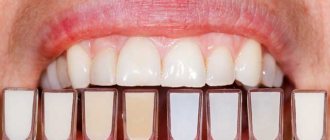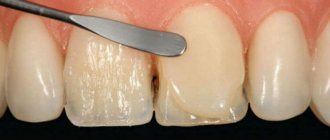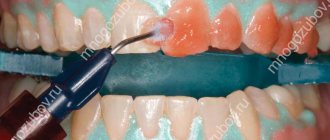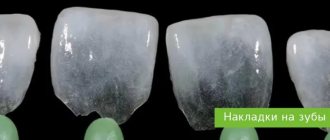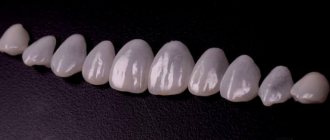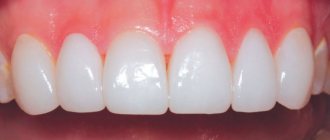17.05.2018
3764
- 1 Reason for changing the color of veneers
- 2 Darkened veneers photo
- 3 Troubleshooting methods
- 4 Prevention of darkening of veneers
Veneers can rightfully be considered a revolutionary achievement in aesthetic dentistry. They allow you to hide many dental defects without the need to resort to surgery, the use of braces and other methods that take time to achieve the desired result.
The greater the disappointment when it is discovered that the veneers have darkened. What could be causing this and how can I solve this problem?
Is it possible to whiten ceramic crowns and veneers, and what whitening methods does dentistry offer?
Dentures made of ceramics or metal-ceramics do not always satisfy the patient with their quality, since the materials can darken over time and be stained by food, drinks, and tobacco smoke. Either the crown or veneer was initially made darker than desired. A logical question arises: is it possible to whiten ceramic teeth? The answer is not always clear, but there is always a solution to the problem. Read more about this in today's article.
Meet veneers
Veneers are the thinnest veneers that are attached to the front surface of the teeth, thereby hiding their defects and improving their cosmetic appearance. This is a modern type of microprosthesis used to correct the appearance of the front teeth (“smile zone”).
Such plates are made individually, using composite materials or porcelain as the basis. The use of the latest technologies in manufacturing and installation allows us to achieve reliable fixation and the same wear as natural teeth. For example, the service life of veneers made from ceramics is practically unlimited. Ceramics are known to be resistant to caries.
At the same time, the uncovered part of the tooth, if not properly cared for, may well begin to decay, thereby reducing the service life of the veneer itself.
But this can be avoided by providing your teeth with proper care and the most careful treatment possible.
What methods of whitening are there in dentistry?
Before we figure out how to whiten ceramic[1] teeth, let’s first look at what whitening methods exist. So, the methods by which you can whiten living enamel are essentially of two types:
- abrasive (mechanical): small and hard particles of the whitening agent scrape off plaque and pigmentation from the surface of the teeth. The clinic uses the Air-Flow hardware method for this, when a mixture of air, drops of water and fine powder is applied to the patient’s teeth under pressure. At home, pastes with a high abrasiveness index (RDA more than 100) are used. It is impossible to whiten stubborn stains, just as it is impossible to make teeth lighter than their natural shade,
- chemical: it whitens the enamel from the outside and a little from the inside - it depends on how deeply the bleaching agent penetrates. The whitening gel contains hydrogen peroxide and/or carbamide peroxide. Using this technique, you can lighten your teeth by 8-12 shades in a clinic and by 2-3 shades at home.
The chemical technique, in turn, can be supplemented by activating the whitening gel with a special lamp - LED, ultraviolet, laser. These are the most effective methods, because... they provide 10-12 shades of whitening.
I have been wearing veneers for 5 years and I can tell you about them what you were embarrassed to ask your dentist about.
The Hollywood smile has long become the same cherished desire of many women as a chiseled figure and smooth skin.
In order not to be afraid to smile widely with all 32 teeth, some people are ready to wear braces for years, do whitening and even install veneers. 5 years ago I decided to undergo such a radical upgrade of my teeth and now I can tell you something about veneers that dentists rarely talk about. I want to share my experience with Bright Side and tell you more about these popular ceramic onlays, answering 11 pressing questions that most people are embarrassed to ask their dentist.
Do I need to get used to veneers?
Oddly enough, yes. For example, in my case, the veneers were much larger than my own teeth, so after installation I began to have a lisp and was very scared . About a month later, diction stopped putting a spoke in my wheels, and everything returned to normal. The doctor explained that many people face this problem.
Is it necessary to file down your teeth?
The phrase “filing down teeth for veneers” sounds scary until you know what it means. As a rule, up to 0.5 mm thickness is removed.
Sometimes, with various defects of the teeth (ugly shape, chips), more significant “filing” is necessary. In any case, this point is discussed in advance with the patient.
How will I know if I will like the end result?
Dentistry has long been digital: the doctor uses a computer to create a virtual project of your future smile and shows what the result will be. In my case, everything turned out exactly as shown in the processed image, and I was very pleased with the work done.
Do veneers always look unnatural?
It all depends on your tastes and preferences. Some people specifically install veneers on all teeth and choose the snow-white enamel color. Often, to make the smile look more natural, veneers are installed on the upper 4-6 teeth and choose a medium degree of whiteness . In this case, only the dentist will be able to guess that you have veneers.
Are tooth roots removed when veneers are installed?
No. But before installation, the doctor takes a photo of the teeth and checks whether all the teeth are healthy and there are no caries, cysts and other problems.
Can veneers fall out or fall off?
No, veneers are very tightly bonded to the underlying tooth enamel - they can only be chipped off together with your teeth or filed down. But some solid foods, such as nuts and apples, are best forgotten .
Do veneers require any special care?
I am often asked how I care for my veneers. The answer is extremely simple: not at all . The hygiene of veneers is no different from regular teeth; they need to be cleaned with a brush and floss. True, there is one cool plus: less plaque accumulates on them and they cannot turn yellow.
Is there a guarantee for veneers?
Yes, but it is different in all clinics - usually the period is from 3 to 5 years . In addition, for example, in dentistry, where I did, throughout the entire life (not just the warranty period), the patient has the right to come for free to check the veneers once every six months.
How does the face change after installing veneers?
In addition to getting a whiter smile, you may also experience slight facial deformation. This happens in cases where veneers are very different from natural teeth in shape and size . For example, such changes have benefited me: friends often say that years after the installation of veneers, the lower part of my face began to look narrower and more harmonious.
How long does it take to install veneers?
In my case, the whole process took 3 visits to the orthopedic doctor. At the first consultation, a specialist examines your teeth, takes the necessary photographs and measurements, and then uses a computer to construct a photo of the final result.
The next visit takes several hours. During this process, the teeth are filed down and temporary ceramic onlays are placed on them, which look almost the same as future veneers. After about 2 weeks, the veneers are installed, which lasts about 2–2.5 hours.
A month later, the doctor invites the patient for the first scheduled check to assess how successful the installation was.
Are veneers for life?
10 years after the installation of veneers, their survival rate is 95% - such data is contained in a review of international studies. As my orthopedist says, many of his patients have been wearing veneers for more than 20 years.
However, sometimes people replace veneers because they become tired of the color . Many years ago, the trend was snow-white and slightly unnatural overlays. Now more and more patients want strangers not to know that their dentist has worked on their smile.
Would you like to get veneers or are you quite happy with your smile?
Can dentures be whitened?
Can ceramic teeth be whitened? Imagine ordinary dishes made of ceramics and glass - these compositions are inert to chemical bleaches, peroxide, vinegar and other acids, and alkalis. After all, even in laboratories, aggressive chemicals are stored in such containers - and the shade of their walls does not change.
Thus, ceramic veneers, crowns, restoration inlays, and bridges cannot be whitened using chemical methods. Or just lighten the surface darkening a little - and then while it is “fresh”. Those. until the dyes and plaque have eaten into the microscopic pores and cracks on the surface of the ceramic. Abrasive pastes will also only remove surface deposits, and can only harm the prosthesis itself - if solid particles scratch the top coating, it will lose its aesthetics even faster.
Lifetime
The duration of operation of the plate, which replaces the outer layer of teeth, depends on its strength.
Composite products are made from high quality composite filling composition. Patients prefer such products because of their affordable cost; moreover, this type of restoration can be used by any dentist.
But you shouldn’t count on long-term cosmetic effects. Such products remain on the surface of dental elements for no more than 5 years and quickly change their original shade.
Ceramic veneers have a longer service life. Due to their good resistance to staining and stress, such plates serve their owner for at least 15 years , and with good care this period can be doubled.
The effectiveness of dental restoration with plates depends on the following factors:
- material used in manufacturing;
- physiology of teeth;
- individual structural features of the dentofacial apparatus;
- food consumed by the patient;
- compliance with the recommended rules for caring for products.
The video provides additional information on the topic of the article.
What to do if ceramic dentures are darkened by plaque
How to whiten ceramic teeth that have become darker due to bacterial plaque? It has already been noted that it is impossible to bleach ceramics. But you can make it lighter with the help of dental procedures - for example, by removing tartar and plaque using professional oral hygiene. It is carried out by dentists - a therapist and a hygienist. The stone is very carefully removed from teeth and dentures using an ultrasonic scaler and hand instruments - it is important that the ultrasonic waves do not disturb the fixation of the orthopedic structure.
And plaque is removed with gentle air-abrasive Air-Flow (“Air-Flow”). Next, doctors use a professional paste for cleaning, and at the end of the procedure they perform polishing. An additional bonus of professional hygiene is that your own enamel becomes 1-2 tones lighter.
Important points
The veneering procedure has a positive effect on the condition of the gum tissue. This can be achieved by precisely adjusting the edge lines of the veneers to the gums.
However, in some cases, patients complain of gum inflammation, pain and bleeding. If such undesirable manifestations were noticed, this indicates the emergence of serious problems.
Most likely, during the process of fixing the onlays to the teeth, medical errors were made, the elimination of which is the prerogative of the orthopedist who performed the installation.
Let's consider the signs that become a good reason for a visit to the dental clinic:
- swelling of the gums , pain, bleeding, painful and unpleasant sensations;
- poor fit of the lining to the surface of the unit;
- mobility of the product even at low intensity;
- the appearance of cracks and notches in certain areas of the microprosthesis;
- formation of gaps in places in contact with the tooth;
- roughness of fastening areas;
- the presence of carious lesions on the open part of the unit.
At the appointment, the doctor carefully examines the patient’s oral cavity and evaluates the current clinical picture.
Depending on the complexity of the case, the microprosthesis is replaced or the product is adjusted. For example, in a situation where a small chip has formed on the surface of the lining, the problem area can be polished.
Is it possible to lighten an artificial tooth that has been made too dark?
No, you won't be able to do this. After all, the shade of the ceramic is selected at the stage of making the prosthesis - then the product is baked in an oven, and the color is fixed forever. If the dentist made a mistake with the shade, then he will either have to redo the prosthesis (change the ceramic lining on a metal-ceramic crown, for example), or even make a new orthopedic structure.
There is another option - to apply a special white varnish on top of the ceramic prosthesis (for example, Dental Paint). It will paint the crown or veneer only on top, and after several cleanings it will wash off. Therefore, such a solution to the problem cannot be called a high-quality solution.
Contraindications to Lumineers
Installation of plates is contraindicated in the following cases:
- bruxism;
- pathological abrasion of tooth enamel;
- presence of periodontitis. In this case, it is recommended to first cure the manifestations of the disease and only then engage in dental restoration.
- are placed only on healthy teeth or teeth with minor defects
- installation of lumineers is also contraindicated in case of enamel hypersensitivity. The glue contains fluorine, which has a beneficial effect on its condition. But installing onlays on hypersensitive teeth can be accompanied by severe discomfort. Therefore, in case of increased sensitivity, a preliminary course of treatment is recommended.
How to whiten darkened teeth if you have crowns and other dentures
If, while wearing ceramic dentures, your teeth become darkened by plaque or tobacco, you can whiten them. To do this, the dentist will select the optimal method for the patient, based on the condition of the teeth - whether they are healthy, whether they have cracks or fillings. Whitening methods in the clinic and at home have already been discussed above. But if, for example, only the old filling has darkened, then it is worth replacing it - putting a new one in the desired shade.
Read on the topic: artistic restoration with a filling - how to make your smile more attractive in 1 visit to the clinic.
You can also cover your natural teeth with veneers or crowns (if they are severely damaged) in a color that perfectly matches the shade of the crowns, bridges or veneers already in your mouth.
Darkening of veneers
It happens that soon after installation, patients complain about darkening of the veneers. What to do if the veneers have darkened? As you know, veneers come in two types of materials: composite or ceramic.
Composite veneers can, unfortunately, sometimes darken. In this case, they require complete replacement, since they cannot be bleached. But sometimes owners of ceramic structures also complain about changes in their color. What to do in such a situation?
The ceramic itself cannot darken. But sometimes patients experience de-cementation and coloring pigment from food gets under the prosthesis through microcracks. Only your dentist can figure out why this happened.
But it is rarely possible to remove the veneer intact. Typically a new structure must be fabricated and installed.
Caring for veneers is not difficult, but it requires self-discipline and systematicity. And then this super invention will provide you with a perfect smile and external attractiveness for many happy years.
Sources used:
- Ministry of Health of the Russian Federation
- Masek, R. (July 1999). "Reproducing natural color effects on milled ceramic restorations." International Journal of Computer Dentistry.
- “Direct veneers of anterior teeth” (Salova A.V.)
What can you do at home?
It is impossible to strongly whiten ceramic teeth at home. But maintaining them in their original condition, as well as removing a thin layer of plaque, is possible if you adhere to the following recommendations:
- rinse your mouth with water after every meal or if you have drunk a brightly colored drink (tea, coffee, wine, grape or pomegranate juice),
- thoroughly brush your teeth and dentures: morning and evening, sweeping movements from the gums to the incisal edge,
- use special toothpastes: on the shelves of stores and pharmacies they are marked “for dentures” and “for braces.” For example, such products are produced by the brands ROCS PRO Brackets & Ortho, Corega 2 in 1, SILCAMED,
- It is also better to buy a special toothbrush, with a large number of bristles: for example, from the company CURAPROX,
- carefully use long-lasting lip cosmetics so that they do not come into contact with artificial teeth,
- Visit your dentist regularly for checkups and professional, gentle cleanings.
“After undergoing prosthetics with ceramic crowns, I immediately bought myself a toothpaste, which I used with braces at school. Cleans very well, teeth are always white and little plaque appears. It is, of course, not very cheap. But not too expensive, quite acceptable for maintaining beauty. And, of course, I go to my dentist once a year or even more often. Because professional hygiene is the best way to clean plaque and tartar, because they build up in all people over time.”
Katty, review from the woman.ru forum
Principles of care
The basic rules for caring for veneers are not too different from normal oral hygiene. You won't be required to change your daily routine or carry a toothbrush with you everywhere. But some points should still be taken seriously.
Immediately after veneering, you should minimize the consumption of food and drinks with coloring properties.
First of all, these are coffee, tea, red wine, chocolate, beets. These foods do not require complete exclusion from the diet, but it is better not to get carried away with them. It is also worth giving up smoking, because exposure to nicotine will significantly worsen the cosmetic effect you have achieved.
Veneers themselves do not perform any protective functions. Their design is designed for certain chewing loads, but it is highly undesirable to overload them.
Therefore, you should not allow hard objects to come into contact with your teeth. You cannot bite nuts, caramel, gnaw seeds, or use your teeth to open lids and packages. Otherwise, there is a risk of splitting the prosthesis, or even damaging the tooth itself. For sports, it is recommended to use special mouthguards that will protect teeth from mechanical damage.
How to protect yourself from problems with dentures
In order for new teeth to maintain an attractive appearance for a long time and not cause other problems, you must initially carefully approach the choice of a clinic and an orthopedic dentist. It is advisable if dentistry has its own dental laboratory, where modern and high-quality ceramic materials are used. For example, ceramics, glass ceramics, fluorapatite, zirconium dioxide from Ivoclar Vivadent (IPS E.Max), Prettau, Kuraray Noritake, VITA Zahnfabrik. And the specialists were trained by material manufacturers, i.e. know how to handle them correctly.
Another important step is that before prosthetics, professional cleaning with ultrasound and Air-Flo is required, and sometimes professional whitening. After all, if your enamel is covered with plaque, then it looks darker than its natural shade - that is, the prosthesis will be made the same color. And then the patient wants to whiten his teeth or even just have his teeth professionally cleaned - as a result, the crown or veneer will turn out to be darker than the rest of the row. Therefore, do not neglect professional cleaning BEFORE prosthetics - a good dentist himself will offer to undergo it, because... understands all the risks.
Can I use dental floss?
There are no clear prohibitions on the use of dental floss and interdental brushes, but you need to be extremely careful when using them. After prosthetics, microgaps between teeth are naturally preserved. But here it is very important not to move the thread from the gums to the edges (i.e., not to make vertical movements) - of course, not immediately, but gradually due to such actions the lining can be damaged. If you want to use floss, insert the tip not from below (from the cutting surface), but directly into the area between the teeth in the gum area - into the largest gap. After cleaning, remove it in the same way.
The same with brushes - when you remove them from the interdental space, be extremely careful. Choose the thinnest brushes. And best of all, buy an irrigator. This is an excellent replacement for both dental floss and brushes.
“Pay special attention to the condition of the gums, especially where the mucous membrane comes into contact with the edge of the veneer or lumineer. Due to tissue injury, inflammation may occur, which will lead to the fact that the pads will have to be removed for treatment, or due to a violation of aesthetics. For example, if gum recession begins and the roots of the teeth become exposed.”
